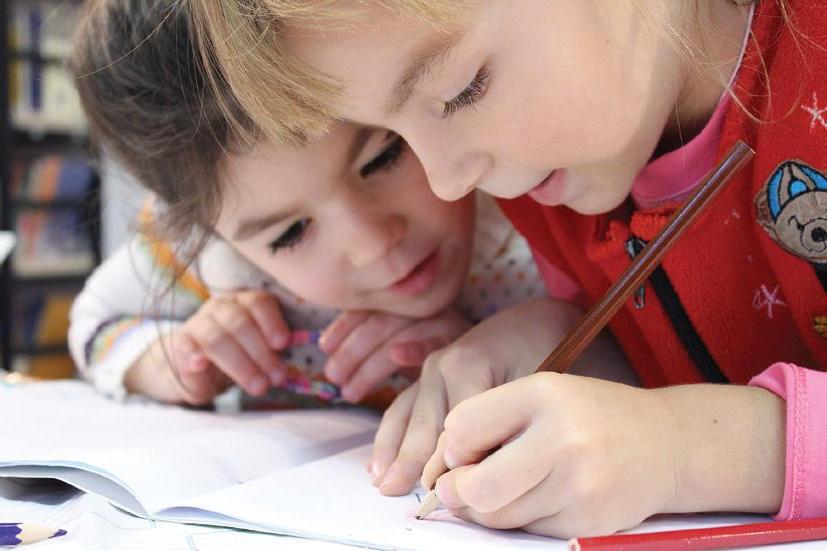
16 minute read
Joining the Spectrum
by DFWChild
Autism diagnoses are more common than ever— here is a guide to your first steps if you think your child might be on the spectrum
WORDS ALEXIS PATTERSON
Advertisement
LEXA WATT REALIZED SOMETHING WAS DIFFERENT
with her son Trace at his 18-month checkup. “There is a questionnaire aimed at screening for developmental and social delays,” the Fort Worth mom explains. “He was supposed to be saying multiple words, pointing to things and expressing his wants and needs with words or vocalizations of some kind. I was pretty surprised, because he said only ‘Mama’ and ‘Dada’ and occasionally ‘ba-ba.’ He did not have any other words and rarely pointed at things.”
The pediatrician didn’t necessarily suspect autism spectrum disorder but still recommended a referral. Watt and her husband decided to wait until after their next baby was born—Watt was almost through her second pregnancy—to see if Trace acquired more language.
He didn’t. “Again, I shrugged it off,” Watt recalls. “There was a new baby in the house, and that rocked his world. I thought, Some kids don’t talk until 3 or 4, right? I guess I was always questioning what we should have been doing, but in the postpartum haze we kept putting it off. If I’m being honest, a big part of that was not wanting to admit something wasn’t right.”
The family received an initial diagnosis of a significant speech delay. Trace plateaued in speech therapy, and sensory symptoms begin to appear. He was finally diagnosed with autism shortly before he turned 4; he’s now 5. “Trace is an extraordinary, loving child with an amazing mind,” says Watt. “Socially, we have a lot of work to do.”
EARLY SIGNS
The road Watt is now walking has been traveled by many parents, including Frisco mom Monica Piper. She first suspected a difference in the development of her son Shawn, now 17, when he was about 9 months old.
“We had three neighbors with children about the same age, and the kids were starting to babble more, interact more and really looking at things. None of that was happening with Shawn,” Piper recalls.
Signs of autism usually appear early, as they did in Shawn. “Most parents report noticing symptoms before 2 years of age, with many reporting symptoms before the age of 1,” notes Clinton Smith, a licensed psychologist who works in the Center for Autism and Developmental Disabilities at Children’s Health and as an assistant professor in UT Southwestern’s psychiatry department.
Some children with autism hit their milestones and then regress, which often happens at ages 18–24 months. In that case, Smith says, a child may lose most of their words and become disengaged. Other kids on the spectrum don’t hit their milestones in the first place. By 12 months, if a child is not babbling, not using gestures such as pointing, not smiling at those around them, and not responsive to or interested in others, the chance for an autism diagnosis increases. Shawn Piper displayed all these signs.
At 18 months, most neurotypical children use at least single words, and by 2 years, they use two-word phrases. Shawn did not. “He didn’t say his first word until past 3 years old,” says Piper.
Even simply uttering words isn’t enough. “The language has to be
spontaneous and involve more than a child repeating what others have said or using the same phrase in a repetitive manner,” says Smith.
In addition to language and communication signs, repetitive behaviors are often noticeable in toddlerhood: flapping hands, teeth grinding, spinning for extended periods, moving hands or fingers in unusual ways or body tensing.
Girls sometimes present different signs. They are usually diagnosed later than boys, and the current ratio is four boys diagnosed for every girl. But Smith says that statistic may not be an accurate reflection of autism prevalence. “Many believe this is due to girls developing language at a similar rate to their peers. They also tend to engage with others more than boys on the spectrum,” Smith says. “Girls with autism may use more repetitive language, echo each other’s speech, struggle to adapt to changes, speak with an unusual voice or struggle with physical boundaries.”
Not all children who miss their milestones have autism, notes Smith, but an early evaluation is key to starting treatment. If you’re seeing any of these signs, bring them to the attention of your child’s pediatrician—even if it’s hard to admit your child could be developing differently.
“It’s so devastating to go through that as a parent,” shares Watt, Trace’s mom. “I felt like I wasn’t parenting him right and was terrified there was something ‘wrong’ with him. I tried to explain it away by telling myself that the milestones are just averages, that all children are different and develop in their own time. And that is absolutely true, but it is not an excuse to look the other way when your child isn’t checking all the boxes.”
LATE BLOOMERS
While both Watt and Piper received diagnoses before their boys reached kindergarten, an autism diagnosis can come later. Shelly Parrill says her son Aaron was speaking in full sentences at 15 months, and everything seemed fine in his younger years. But behavior problems surfaced when Aaron was 4 years old. Starting kindergarten in his Hurst-Euless-Bedford ISD neighborhood school was a “nightmare” because of Aaron’s issues, recalls Parrill.
Aaron initially received a diagnosis of “emotional disturbance.” In first grade, he began developing tics, such as coughing and making a “hee-haw” sound. He was also continually chewing on his shirt. Though Parrill says Aaron was extremely smart, his academic performance dropped. And the behavior issues escalated to include throwing chairs in the classroom.
While Aaron was receiving life skills therapy from a local center, Parrill pulled him from class to homeschool him. During this time, he received another diagnosis: pervasive developmental disorder – not otherwise specified. Aaron returned to public school in a special education program, and district specialists told Parrill they believed her son had Asperger’s (now termed high-functioning autism) when he was in third or fourth grade.
Smith says it’s common for children who are high-functioning to not receive their autism diagnosis until an older age. They may meet developmental milestones as a baby, then later show signs. Children with high-functioning autism “may re-enact commercials or other things they see in media, with few attempts at spontaneous, imaginative play,” explains Smith. “They tend to echo others’ speech and are highly routine-oriented.”
Some children on the spectrum are also very rules-oriented. “Other children may view them as a ‘tattle-tale,’ or they may be able to be only a leader or only a follower in play, and not switch roles,” Smith adds. He goes on to say that these kiddos may have trouble responding to social cues, and it can be tough to redirect them from a favorite topic.
Older, more high-functioning children on the spectrum may have their symptoms identified in school. But schools can play an important role in assessing younger children too. Most public school districts have an early childhood team that is tasked with evaluating kids nearing their third birthday through age 5 for developmental issues. Referrals for evaluations could come from day cares or private schools; in HEB ISD, most evaluation requests come from parents, according to René Riek, the district’s director of special education and dyslexia. The evaluations are free. Still, it’s common for parents to also consult a health provider. “The school district typically completes an evaluation for eligibility to receive special education services under the designation of autism spectrum disorder. This is not a diagnosis of autism,” says Smith. “Parents who wish for their child to receive services or governmental supports will need medical confirmation.”
FIRST STEPS
If you think your child might have autism, your first step is to document your concerns. “What are you noticing?” asks Smith. “When do you notice it? How often is it happening? Videos of the behavior can be helpful.” Bring that information to your pediatrician, who can refer your family to a specialty clinic.
Smith says there is some misinformation—even among medical and mental health professionals—that formal testing for autism is appropriate only after the age of 3. “This is incorrect. The testing instruments used in autism evaluations can be used at 12 months of age, and we can give the diagnosis as early as need be,” he states.
At Shawn Piper’s 9-month checkup, his pediatrician gave his mom the name of a developmental pediatrician—a specialist for children with developmental, learning or behavioral issues. Around the age of 2, Shawn underwent a full assessment. “They said, ‘We can’t rule in or rule out autism,’” says Piper. “They started by recommending six months of therapy and then reassessing.”
Speech therapy, occupational therapy, music therapy, play therapy—Piper and her husband did every kind of treatment offered for Shawn at that time. “Then they did another evaluation, and he received the autism diagnosis.” Shawn was about 2½ years old.
For the Pipers, the diagnosis process was fairly swift and straightforward. Unfortunately, that doesn’t always happen. Aaron Parrill, remember, went through two different diagnoses before his autism was recognized in elementary school. And Alexa Watt’s son Trace received only a diagnosis of speech delay when he was 2, after what Watt calls a “cursory” assessment that took less than an hour.
When Trace was 3, the family pursued another evaluation, but he couldn’t be seen right away. “About four months into that waiting period, he was so far behind where he should have been, and I was getting frantic,” Watt says. “We started the process of getting an academic diagnosis through Fort Worth ISD, and that process was quicker and more streamlined. They diagnosed him with autism four months shy of his fourth birthday, and two months later, we finally got his medical diagnosis.”
Trace has a mild to moderate form of autism, in addition to a speech disorder. His mother still considers what she might have
done differently.
“Hindsight is everything, right? I really wish we would have gotten a second opinion earlier than we did. I wish at Trace’s first evaluation we had insisted on a thorough assessment,” she admits. “I wish I could say ‘Trust your gut,’ but honestly, with autism, our parenting instincts can sometimes lead us astray. My gut told me he was fine and developing in his own way, but that mama bear instinct blinded me from the truth: that he needed intervention.”
TREATMENT PLAN
For many children diagnosed with autism, that intervention may come in the form of applied behavior analysis (ABA) therapy. “ABA therapy helps teach basic skills to kids on the spectrum,” explains Monica Piper. “It focuses on three main areas: communication skills, social skills and challenging behaviors like aggression or tantrums that a lot of kids present.”
Piper isn’t speaking only from her own experience as a mom. After her son showed improvement through ABA, she decided to make the therapy her life’s work, eventually opening her own practice, called Stepping Stones Consulting Services, which provides inhome ABA therapy in Collin County and surrounding areas.
In addition to working on communication, an ABA therapist might help a child on the spectrum learn to manage independent tasks (how to dress, brush their teeth, wash their hands and do chores) as well as improve basic competencies (letters, reading, counting and so on). High-functioning kids may get a few hours of therapy a week, while others go up to 40 hours a week.
If you have a younger child, you can tap into the state’s Early Childhood Intervention (ECI) program. ECI is designed for families with a child up to age 3 who has developmental delays, disabilities or certain medical conditions that affect development. In addition to providing assessments, ECI specialists will develop a plan for your child and provide services (which can be administered at home, a park, the library or another setting).
As your kiddo grows, schools can also provide services or work in tandem with other professionals to ensure the best outcome for a child. There are specialty private schools, as well as special education and mainstream class accommodations delivered through public schools.
Districts like HEB ISD work closely with families to develop an individualized approach. “There’s a saying that if you’ve met one kid with autism, you’ve really met only one kid with autism,” says Riek, the director of special education and dyslexia. “And as kids get older, we want them to be part of their plan. We sit down with them and say ‘What’s working? What’s not working?’ The plan needs to evolve as the child grows and changes.”
SUPPORT SYSTEM
This all may seem overwhelming if you’re new to the spectrum—and that may be just one of many feelings you experience. “Some parents have a sense of validation and relief, while other parents experience various degrees of grief, guilt or anger,” reports Smith. “It’s OK to not be OK. There are many professionals ready and equipped to help both your child and you.”
Smith suggests that parents who receive a diagnosis focus on one recommendation at a time, while also seeking their own emotional support. Counselors and therapists can help moms and dads talk through their experiences, and parent-to-parent support groups may be available through your child’s assessment or treatment provider. You can also search out groups in the community and on social media; Watt is part of the #MomStrongFW group on Facebook, which connects moms of children with autism in Tarrant County.
Piper says when you’re growing your personal network, try to find a parent who has lived the reality of autism for a while. “I think it helps mothers with younger kids or newly diagnosed kids to find moms with older kids,” she says. “You get a sense of what you might be able to expect down the road. Life can still be good. You still love your kid. You don’t want your kid to have autism, but it’s not the end of the world.”
Parrill points out that kids with autism are often very passionate, and some have great gifts. For Aaron, it’s art. “We bought art supplies out the wazoo,” she laughs. “Find your child’s strong suit. Encourage it.”
Shawn Piper is blessed with perfect pitch and enjoys performing. Alexa Watt believes her son Trace may have a photographic memory, and he has a talent for numbers and patterns. Bottom line: Keep the right perspective. “These kids develop differently,” emphasizes Watt. “They have minds that surpass understanding. We have to tap into those differences and use early intervention to help them realize their full potential in a world that isn’t always aware of or sensitive to their uniqueness.”
Want to learn more? Listen to our DFWChild podcast for an interview with Monica Piper.
Autism on the Rise?
Facts & figures from the CDC
Estimates indicate 1 in 54 children is identified as having autism spectrum disorder (ASD). That is about 1.85% of kids. ASD diagnoses are over four times more common in boys than girls, but autism is found in all races, ethnicities and socioeconomic groups.
While ASD diagnoses are more common than ever, it is unclear whether that is because of better diagnosis processes and a broader definition of ASD, or an actual increase in the number of people with autism. Numerous studies have investigated whether there is a link between vaccines and autism. Those studies have consistently shown that vaccines do not have an association with ASD.

THE COVENANT SCHOOL “Pursuing Truth, Goodness, and Beauty” THE COVENANT SCHOOL “Pursuing Truth, Goodness, and Beauty”
Th e Covenant School is a Charlotte Mason-inspired K-12 community of faith and learning emphasizing the classical Th e Covenant School is a Charlotte Mason-inspired K-12 arts and sciences. community of faith and learning emphasizing the classical arts and sciences.
At Th e Covenant School, a proven model of classical Christian education is used to teach students to confi dently At Th e Covenant School, a proven model of classical engage the world for Christ through authentic Christian Christian education is used to teach students to confi dently living, wisdom, and virtue. engage the world for Christ through authentic Christian Covenant off ers: living, wisdom, and virtue. • A rigorous curriculum using Socratic instruction Covenant off ers: • Championship winning sports teams • A rigorous curriculum using Socratic instruction • Rich fi ne arts program • Championship winning sports teams • Small class sizes • Rich fi ne arts program • Highly-skilled faculty • Small class sizes • Highly-skilled faculty
To learn more or schedule a visit go to www.covenantdallas.com To learn more or schedule a visit go to www.covenantdallas.com

7300 Valley View Lane, Dallas, Texas 75240 214-358-5818 7300 Valley View Lane, Dallas, Texas 75240 214-358-5818
Faith Lutheran Day School serves children 18 months to kindergarten.

We provide an early childhood setting where each child is encouraged to grow, learn and develop as a child of God.
6000 Morriss Road, Flower Mound, TX 75028 972-691-5491 shapingyounghearts.org
Call us today for a tour!
/faithdayschool


re-imagining EDUCATION IN AN ever-changing WORLD

a safe place to learn
Serving students with learning challenges such as Dyslexia, Dyscalculia, Anxiety and ADD

IN-PERSON CLASSES USING COVID SAFETY MEASURES We use differentiated and multisensory instruction techniques, allowing for multiple intelligence and strength compensations
55 Main St. #290, Colleyville | 817-803-5010 INSPIREACADEMYTX.COM Dana Judd, MEd, CALT, DLT — Owner & Lead Instructor
All children are unique & marvelously made by God

ACCEPTING NEW STUDENT APPLICATIONS

Tuition Assistance Scholarships Available
Serving Grades PK–8TH
• Small Class Sizes & Individualized Approach to Learning • Reading/Writing Workshop Model • STEM Lab, Art, Music & Library Time • Spanish, PE and Recess Daily • Leadership & Community Service • Middle School - Mandarin, Innovation & Entrepreneurship Program • After School Care &
Enrichment Programs • Located in North Oak Cliff,
Convenient to Downtown Dallas
CALL OR VISIT US ONLINE FOR MORE INFORMATION
Now Enrolling 2 yrs–Kindergarten A place where children come first


HTA offers a comprehensive academic program that includes: • Reading/math readiness • Science • Social/cultural studies • Art & music • Greek language • Computer • Orthodox Christianity • PE

To learn more about our school, please contact us at 972. 490.7060.
www.htadallas.com 13555 Hillcrest Rd, Dallas, TX 75240 | 972.490.7060
SACS ACCREDITED







